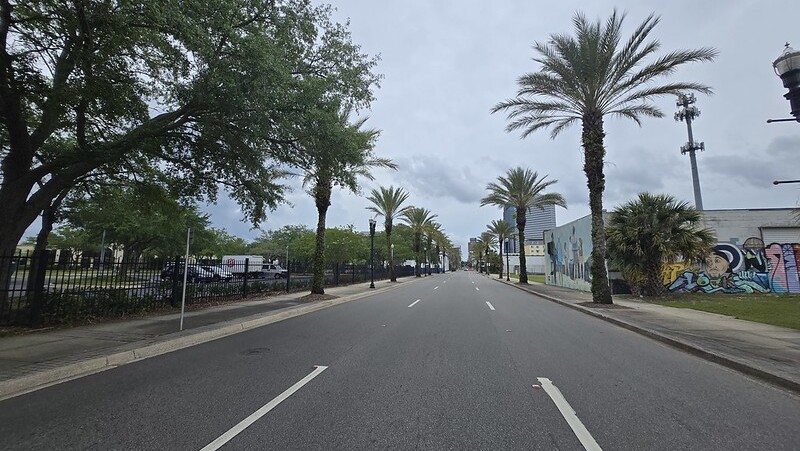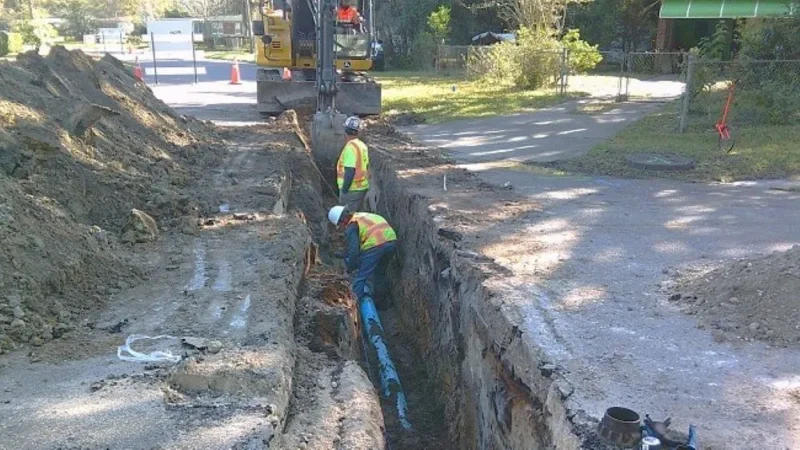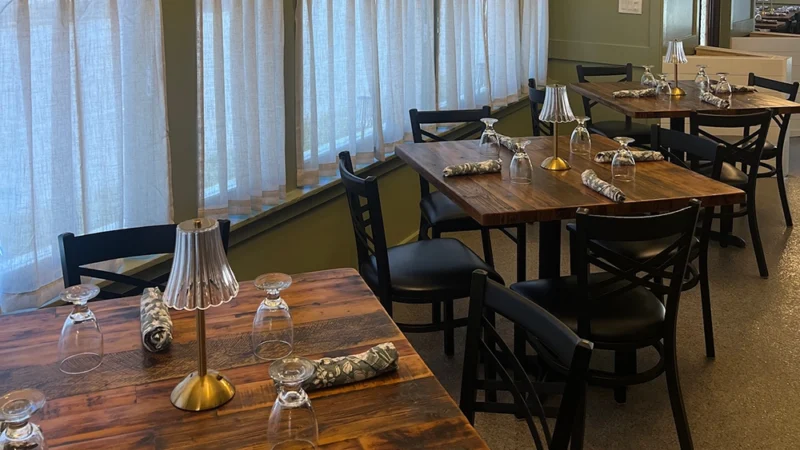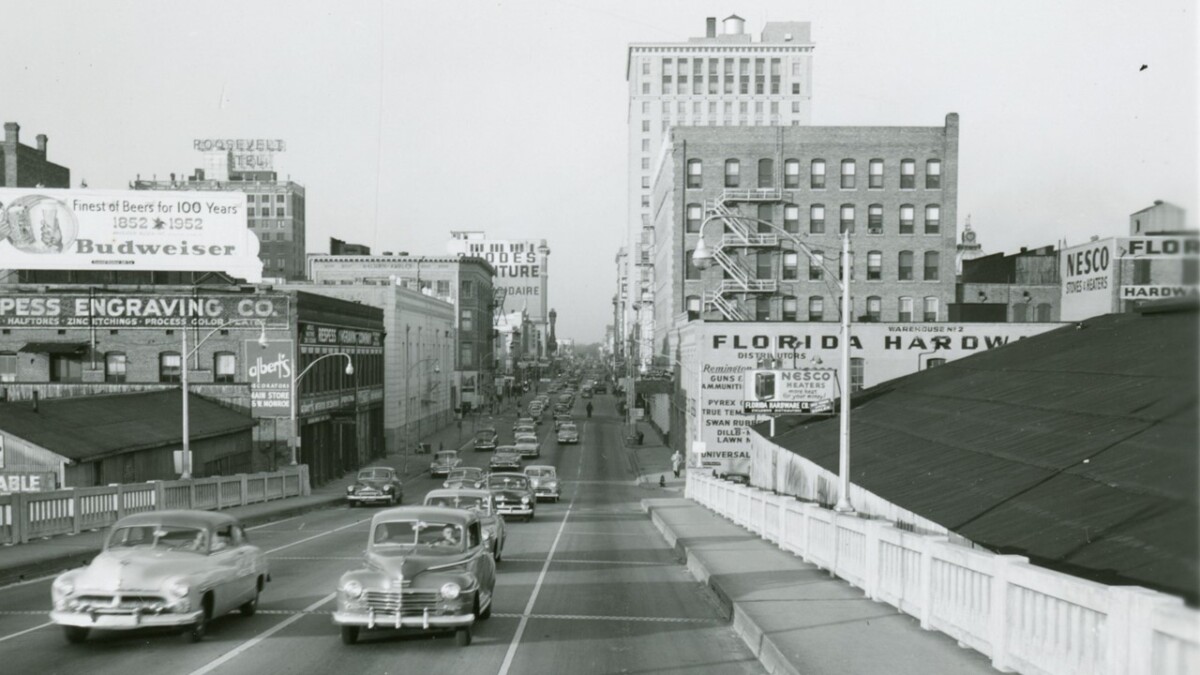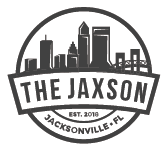
For over a century, West Adams Street was a vital artery in the heart of Downtown Jacksonville’s LaVilla neighborhood. Though much of it was lost to urban renewal, the street is now on the verge of a revival. Three decades after being reshaped by the River City Renaissance plan, here’s a look at West Adams Street — then and now.
The rise, fall, and rebirth of West Adams Street

Once a quiet residential corridor, West Adams Street was a defining feature of LaVilla during its time as an incorporated municipality between 1869 and 1887. Its character began to change dramatically following two key events: the 1897 opening of the Jacksonville Terminal Co.’s Union Depot and the Great Fire of 1901. These developments spurred the street’s transformation from a stretch of modest wood frame homes into a bustling, urbanized thoroughfare.
West Adams Street’s transition toward commercial prominence began at the intersections of Davis and Broad streets. With LaVilla emerging as Jacksonville’s premier railroad hub, the street quickly attracted new businesses. Early commercial development included the opening of liveries and stables as the south side of the neighborhood emerged as the city’s red light district.
In the years following the 1901 fire, the street’s once-dense collection of two-story frame residences gave way to brick storefronts, boarding houses and hotels catering to the growing number of visitors arriving by train. Many proprietors lived above their businesses, lending the area a vibrant, multicultural character, including a small but flourishing Chinese-American community.
Chinese immigrants began settling in Jacksonville during the 1880s, initially finding employment in laundries, restaurants and shops. Many gravitated toward West Adams Street, particularly near “The Line.” The opening of the nearby railroad terminal further increased demand for laundry services, prompting the establishment of Chinese-owned businesses along the corridor.
One of the earliest such enterprises was operated by Chaun Sue Sing at the intersection of West Adams and Bridge (now Broad) streets during the 1890s. By 1910, more than half of Jacksonville’s Chinese-owned laundries were located within two blocks of West Adams. These family-run establishments often doubled as homes for their owners, who lived above their business. By 1920, Chinese entrepreneurs controlled nearly 80% of all commercial laundries in the city, which boasted Florida’s largest Chinese population at the time.
Notable community leaders such as Wah Hop, Sam Sing and Jim Lee played essential roles in building and supporting LaVilla’s Chinese-American enclave. However, the Great Depression, the rise of modern laundry technologies, and restrictive immigration laws led to a decline in this vibrant community. By 1960, only Jim Quan’s laundry on West Ashley Street, a few blocks north, remained in operation.
As the automobile gained popularity, businesses catering to the new mode of transportation, such as the Firestone Tire & Rubber Co., began to appear along West Adams. The street’s economic vitality peaked during World War II. In 1944 alone, the Jacksonville Terminal processed nearly 40,000 trains and served close to 10 million passengers, bringing an unprecedented level of urban activity to the area.
But with the post-war decline of the railroad industry, West Adams Street’s fortunes waned. By the 1970s, LaVilla’s three major depots—the Jacksonville Terminal, the Railroad Express Agency freight depot, and the Atlantic & East Coast Terminal—had all shuttered, accelerating the neighborhood’s economic downturn.
In the 1990s, much of what remained of West Adams Street was demolished under the River City Renaissance initiative, a $235 million urban renewal bond spearheaded by Mayor Ed Austin in 1993. Intended to revitalize LaVilla and other economically distressed neighborhoods, the program razed large swaths of the historic multicultural community.
Yet, in more recent years, West Adams Street has experienced a revival. New infill development projects along West Adams Street include Johnson Commons, Lift Ev’ry Voice and Sing Park, the Emerald Trail and the Lofts of Monroe.
Here is a before-and after-look at this historic Downtown thoroughfare:
The Pruitt Tire Co.


A flourishing Chinese-American community
During the early 20th century, the intersection of West Adams and Madison streets was the epicenter of LaVilla’s Chinese-American community. The majority of the neighborhood’s Chinese-American businesses and residences were located within a two-to-three block radius of this intersection. For example, Wah Hop, who immigrated to the U.S. in 1890, lived and operated a commercial laundry business at 713 W. Adams St. Hop also owned and operated a restaurant one block south at the intersection of Madison and Ward (now Houston) streets. In addition, Hop’s residence was home to Chinese-American boarders who were employed in the businesses.


A walkable mixed-use district

The 800 block of West Adams Street during the 1970s. For several years, Charlie Lee operated one of his two commercial laundry businesses in LaVilla at 806 W. Adams (building on the left). | City of Jacksonville.

The Northern Hotel


The Hotel Flagler
Catering to nearby railroad terminal passengers, the 125-room Hotel Flagler was located at the northwest corner of West Adams and Davis streets. The Flagler was the first hotel owned by hotel magnate Robert Kloeppel, Sr. Kloeppel was a penniless German immigrant who spoke little English when he arrived in America in 1905. Relocating to Jacksonville a year later, he eventually became an attorney who opened a law office in the Flagler Hotel building after working in a local sawmill, railyard and shipyard as a mechanic. A few years after purchasing the Flagler in 1920, Kloeppel renamed the property Hotel Jefferson.



The B.F. Goodrich Co.
Founded by Dr. Benjamin Franklin Goodrich in 1870, the B.F. Goodrich Co. began as a manufacturer of rubberized hoses, which were sold mostly as fire hoses. The company became a household name when Henry Ford selected B.F. Goodrich tires to be fitted in the new Model A Ford in 1903.


Firestone Tire & Rubber Co.
The Firestone Tire and Rubber Co. was founded by Harvey Firestone (1868-1938) in 1900 in Akron, Ohio. Firestone used his personal relationship with Henry Ford to become the original equipment supplier of Ford Motor Co. automobiles. In 1926, the company introduced the first one-stop service station, which was characterized as the greatest service development since the automobile was first introduced. As a part of a $2,000,000 Florida service station building program, Firestone acquired this block, resulting in the demolition of the childhood residence of James Weldon and John Rosamond Johnson. In August 1929, the company celebrated the opening of its large Mediterranean Revival-style, three-story one stop service center and warehouse.


The Universal Film Exchange


Hotel Williams
Built in 1913, the two-story Hotel Williams was also called the Dixie House and Little Ritz Hotel between World War I and the Great Depression prior to being rebranded as the Magnolia Hotel. Offering furnished rooms for Black travelers during a time when they were not allowed in white Downtown hotels, the Magnolia Hotel’s ownership also operated The Pink Tea Room in the building. Several businesses, ranging from Chinese laundries and pool rooms to restaurants and beauty salons, occupied the building’s ground-level storefronts.


Today, Johnson Commons is a two-phase 3.4-acre infill mixed-use development under construction. The first phase of the project involves 91 three-story townhomes with one-car garages that architecturally pay homage to the historic two- and three-story residences that once dominated the LaVilla landscape. A second phase fronting Lee and Forsyth streets could include a minimum of 10,000 square feet of stand-alone retail or a mix of multi-family residential and retail that includes a minimum of 10,000 square feet of retail on the first floor.
Apex Color





